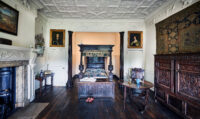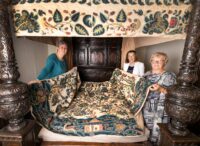 After 10 years of restoration, a set of 350-year-old embroidered bed hangings have returned to the bedroom in a Birmingham mansion where King Charles I slept in 1642. The conservation team included both professional conservators and volunteers who worked together at Birmingham Museums to clean and stabilize the rapidly decaying linen, repair holes and fix loose threads to new linen support fabric by stitching over them (couching).
After 10 years of restoration, a set of 350-year-old embroidered bed hangings have returned to the bedroom in a Birmingham mansion where King Charles I slept in 1642. The conservation team included both professional conservators and volunteers who worked together at Birmingham Museums to clean and stabilize the rapidly decaying linen, repair holes and fix loose threads to new linen support fabric by stitching over them (couching).
 The embroidered linens are in the collection of Aston Hall, a Jacobean mansion built by Sir Thomas Holte, 1st Baronet of Aston, between 1618 and 1635. King Charles honored the great house with his presence in October 1642, mere months after armed hostility with Parliamentarian had broken out. The king stopped at Aston Hall after levying troops at his temporary base in Shrewsbury, and on October 23rd, only days after the king left the comforts of Holte’s hospitality, he and the Royalist army faced the Parliamentarian army at the Battle of Edgehill, the first pitched battle of the First English Civil War.
The embroidered linens are in the collection of Aston Hall, a Jacobean mansion built by Sir Thomas Holte, 1st Baronet of Aston, between 1618 and 1635. King Charles honored the great house with his presence in October 1642, mere months after armed hostility with Parliamentarian had broken out. The king stopped at Aston Hall after levying troops at his temporary base in Shrewsbury, and on October 23rd, only days after the king left the comforts of Holte’s hospitality, he and the Royalist army faced the Parliamentarian army at the Battle of Edgehill, the first pitched battle of the First English Civil War.
Aston Hall was targeted directly by Parliamentarian forces in December 1643. It was subjected to cannon fire for three days before the defenders surrendered. There is still a cannonball hole in the wooden staircase.
The hangings weren’t on the bed when Charles drew Aston Hall into these momentous events. They date to the same period and hang on a bed that also dates to the same period.
Designed using a type of embroidery called crewel work, which was a particular favourite style of the Jacobean period, the embroidered bed hangings comprise two curtains, pelmets and a bed covering. They feature an exquisite Tree of Life pattern, flowers, birds, deer and a Chinese-style pavilion. The wool threads are coloured with natural dyes in shades of blue, green, yellow, orange, red and pink. Embroidered bed coverings were the preserve of only the wealthiest families in the 17th century and such sets of hangings around a bed, gave warmth and privacy.
Jane Thompson-Webb, Conservation Team Leader at Birmingham Museums said:
“It’s a major achievement welcoming these embroideries back on display at Aston Hall. Before the start of the restoration project, they were very dirty, the colours were dull, and it was obvious that the embroideries were in a fragile state and at risk of being lost forever.
“They’ve been superbly restored thanks to our dedicated team of volunteers – with their hard-work these historic embroideries and their fabulous colours, intricate scenes and delicate details have been preserved for many more years to come.”